How To Draw Haworth Projections
Everything you ever wanted to know about converting Fischer Projections to Haworth Projections, And Vice Versa
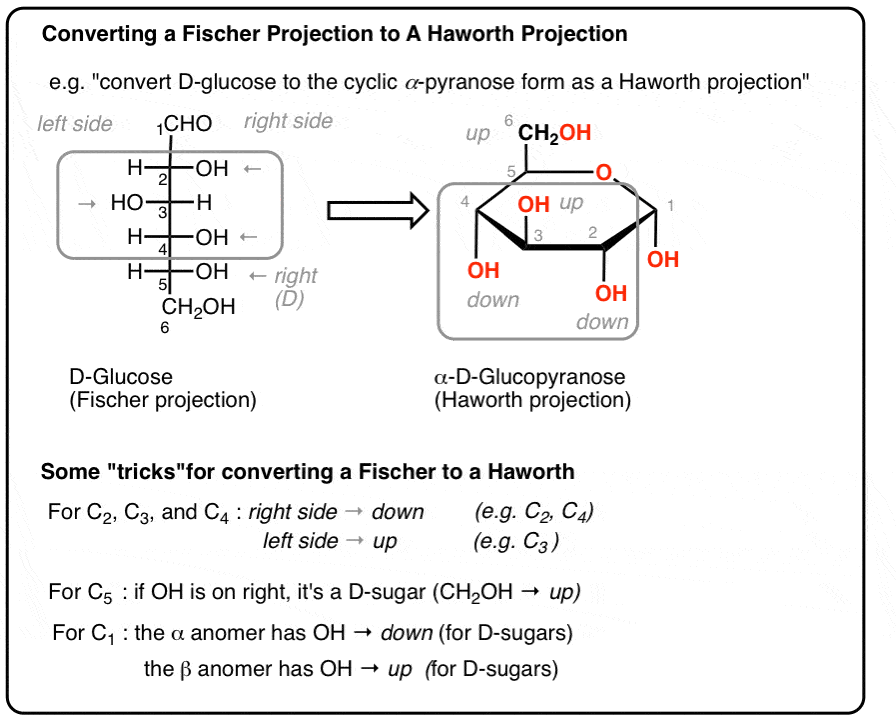
Here's a relatively common problem in the realm of sugar chemistry:
"Convert this (sugar) from the Fischer projection to a cyclic pyranose form as a Haworth projection."
(the reverse question can be asked too: "convert a sugar drawn in a Haworth to an open-chain Fischer. ")
So…. how can we do this?
Well, there are a couple of tricks, and that's what this post is about. (We'll show how to deal with furanoses too.)
Table of Contents
- Converting A Fischer To A Haworth (The Long Way)
- The Fischer-To-Haworth Shortcut: For C2, C3, and C4, Right = Down and Left = Up
- What About C5 and C1?
- Fischer To Haworth Example 1: D-Mannose
- Example 2: L-Galactose
- Example 3: Try Going Backwards!
- What About Five-Membered Rings? (Furanoses)
- Example 4: Fructose
- Notes
- (Advanced) References and Further Reading
1. Converting A Fischer to a Haworth (The Long Way)
Let's start with the example of converting D-glucose drawn in a Fischer projection to a pyranose (i.e. hexagonal) depiction in the Haworth projection – the "long way". [The shortcut is above, BTW. If you want to skip to some practice examples, they're below].
We'll start by remembering what the Fischer projection really represents.
Although all the bonds in the Fischer might be drawn "flat", it's not meant to be understood that way! [See this earlier post on D and L sugars, for example].
By convention, the horizontal bonds on a Fischer projection actually point out of the page.
One way this was taught to me was to remember that "the arms come out to hug you". In other words, they're "wedged".
The first step in converting a Fischer to a Haworth is to draw in these wedges and to number the carbons.

Next, let's turn this molecule on its side, 90 degrees clockwise. [it must be clockwise – see note]

This sets us up to form a bond between the C5-OH and the carbonyl carbon (C-1), which will make a new ring. [If this is unclear, s ee this earlier post on ring-chain tautomerism for more examples.]
It's helpful to perform a bond rotation on the C5 carbon to make the stereochemistry on the ring clearer. Interchanging any three groups on a carbon does a bond rotation. So we'll make the following three "moves":
- H → OH
- OH→ CH2OH
- CH2OH→ H
After rotation, the C5-OH is on the side rather than pointing down. In the figure below I drew it with a "dashed" bond, owing to the tetrahedral geometry on the carbon. I also drew the C2-C1 bond dashed as well.
This sets us up to draw the C5-OH attacking the carbonyl carbon, forming a new O–C1 single bond and breaking the C1-O pi bond.
After proton transfer, we now have one of two rings, which we can depict as Haworth projections!
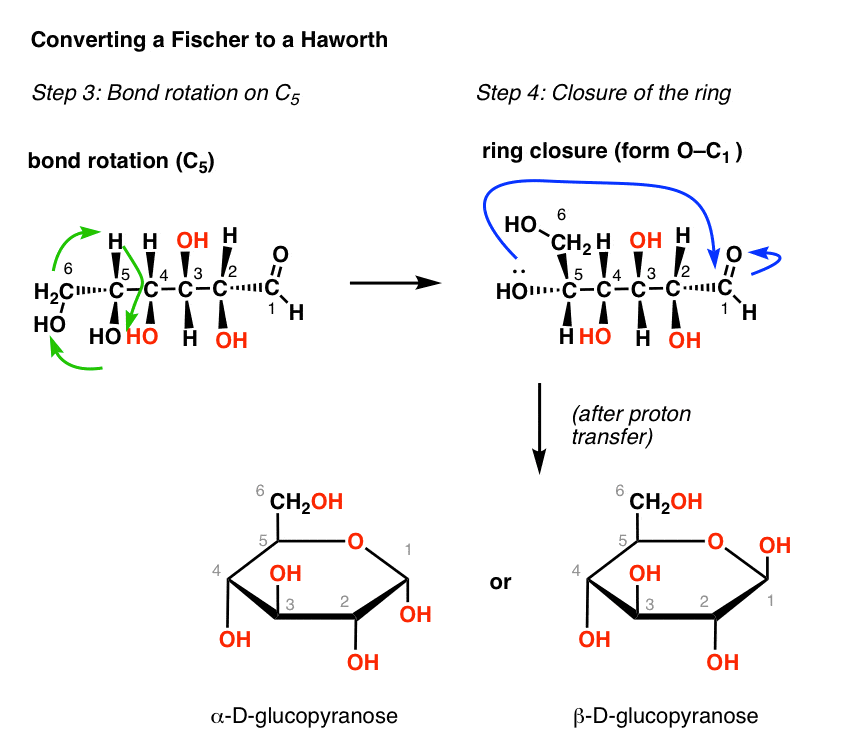
(You can imagine this as being like fastening a belt, with the OH as the "buckle" and the carbonyl carbon as the "notch" in the belt).
Notice thatall the groups that were pointing "up" in our linear molecule (e.g. the C3-OH) also point "up" in the Haworth, and all the groups that point "down" in the linear molecule (e.g. C2-OH and C4-OH) point "down" in the Haworth.
(The one exception is the C1 oxygen, which can be "up" (β in this case) or "down" (α) according to which face of the carbonyl is attacked. )
Voila – there's your conversion of a Fischer to a Haworth. If you're keen, you can even turn the Haworth into a chair, if you start with a template and map all the substituents as we described in the last post.
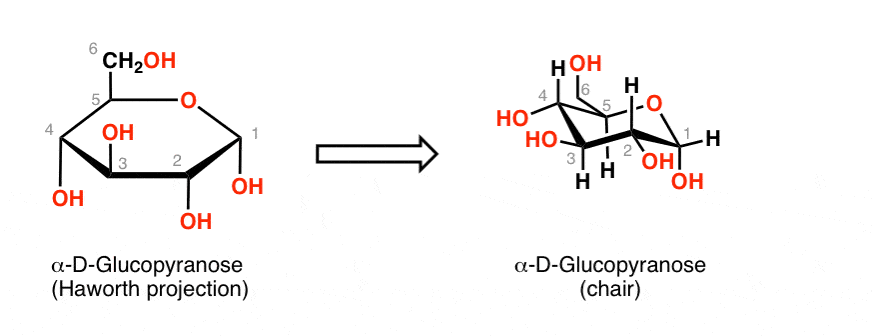
2. The Fischer-to-Haworth Shortcut: For C2, C3, and C4, Right =Down and Left =Up.
Having walked through the process the long way, let's try to come up with a shortcut for this process.
Compare the Fischer projection of D-glucose to the final Haworth:
- C2–OH is on the right side of the Fischer and ends up on the bottom of the Haworth.
- C3–OH is on the left side of the Fischer and ends up on the top of the Haworth
- C4–OH is on the right side of the Fischer and ends up on the bottom of the Haworth
This gives us the following shortcut. If a group is on theleft side of the Fischer, it will end up on the top face of the Haworth, and if it is on theright side of the Fischer, it will end up on the bottom face of the Haworth.
Right-down, left-up.(for C-2, C-3, and C-4, at least)
What about C5 and C1 ?
3. What About C5 and C1 ?
In our example the C5-OH was on the right side of the Fischer, which made it (by definition) a D-sugar. We saw that C6 (the CH2OH) ended up on the top of the Haworth, so we can make a generalization:
- for D-sugars, the C6 carbon will end up on the top of the Haworth
- for L-sugars, the C6 carbon will end up on the bottom of the Haworth.
That leaves us with C1. The hydroxyl group on C1 can end up in one of two configurations – either "up" on our Haworth, or "down"- depending on which face of the carbonyl is attacked.
The standard terminology for these two configurations at the C-1 carbon (sometimes called the "anomeric carbon") uses the terms alpha (α) and beta (β).
In the "α" configuration, the C1-OH is on the opposite face of the ring as the C5 substituent [CH2OH in this case]. For a D-sugar, therefore, the C1-OH points down.
In the β configuration, the C1-OH is on the same face as the C5 substituent. (i.e. for a D-sugar, the C1-OH points up, as does the CH2OH attached to C5 ).

That's the shortcut. So let's do some examples, shall we?
4. Fischer to Haworth Example 1: D-Mannose
Mannose is a hexose where the configuration at C2 is flipped relative to glucose.
Using the shortcuts above, try converting it to a Haworth as an α-pyranose. (answer at the bottom)

5. Example 2: L-Galactose
Now try a more challenging one. Starting with the structure of L-galactose, draw the Haworth as a β-pyranose.
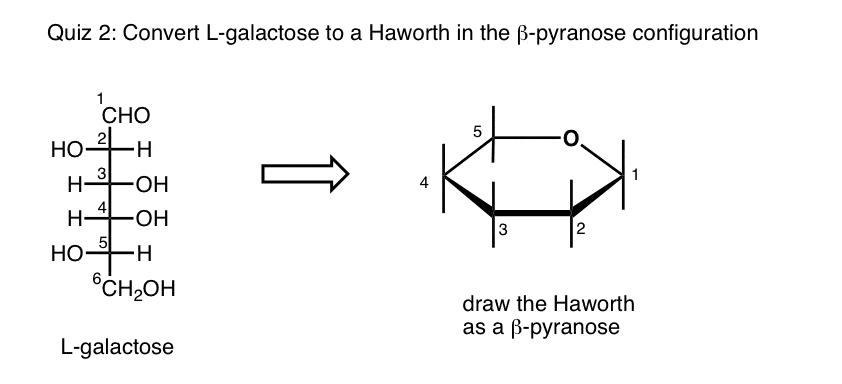
6. Example 3: Try going backwards!
If you know how to go from a Fischer to a Haworth, then you should be able to puzzle through going from a Haworth to a Fischer (it's actually easier).
Try it with L-idose:
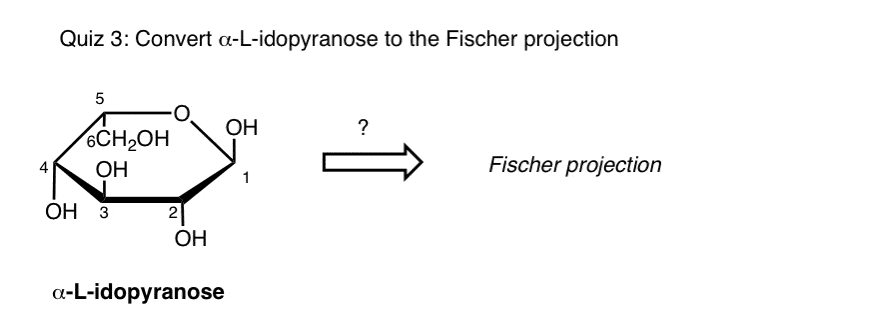
7. What About Five-Membered Rings? (Furanoses)
Haworth projections can be used for five-membered ring sugars (i.e. furanoses) too.
So how do we convert a Fischer to a five-membered Haworth?
The shortcut is essentially the same, but since the C4-OH is usually forming the ring instead of C5-OH, the mnemonic right → down and left → up only applies for the two carbons adjacent to the carbonyl (usually C2 and C3).
So if the C4-OH is forming the ring, and if it's on the right in the Fischer (i.e. D, for a pentose), then the C5 will point up on the Haworth.
Alpha and beta in a furanose are assigned by comparing the orientation of the C1-OH with the C4 substituent (not the C5 substituent, as with a pyranose).
Here's D-ribose converted into its α-furanose Haworth projection. [Notice that the C1-OH is on the opposite face of the molecule from the C4– substituent (CH2OH), which makes the configuration alpha (α) ]
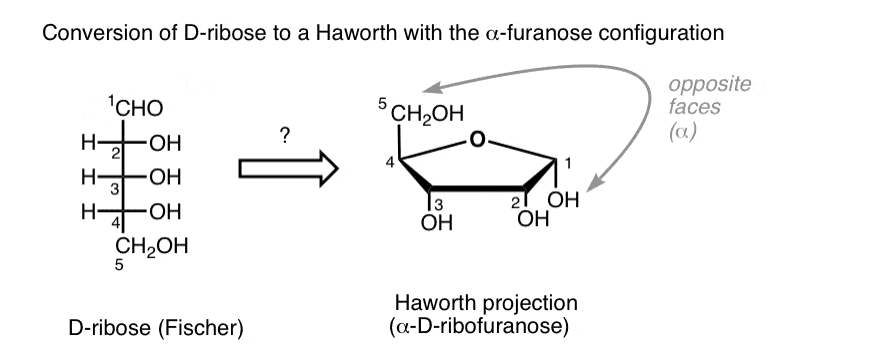
Note how the C4-OH points to the right in the Fischer and the C5 substituent (CH2OH)points up in the Haworth.
8. Example 4: Fructose
If there was a bit torturous wording in the above paragraphs using anif… then clause, that's because I wanted the logic to be just as applicable to fructose, a six-carbon sugar (hexose) which mostly exists in the furanose form.
Fructose is a particularly interesting example because it's a ketose, not an aldose; the ring is formed through the attack of a hydroxyl group to a ketone, not an aldehyde.
So here's the final challenge. Given the Fischer projection, try drawing the Haworth projection ( β-furanose form) for D-fructose, below:
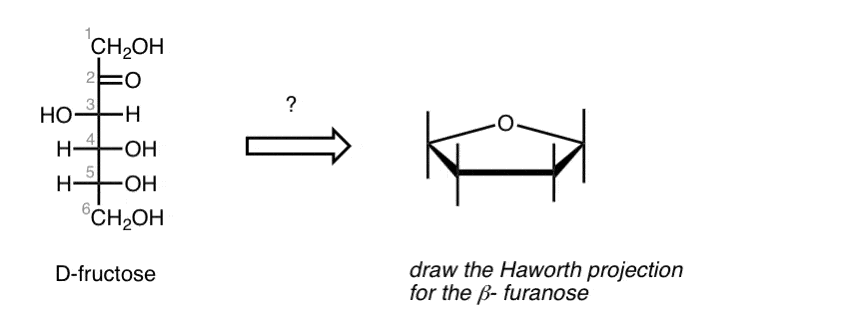
If you can do fructose without help, you're in good shape for an exam.
Notes (and Answers)
- D-Mannose. Just like glucose, but the C-2 OH is flipped.

- L-galactose. A bit of a weird one. Note that if you remember "alpha" as the C1-OH being "up", that only works for D-sugars.
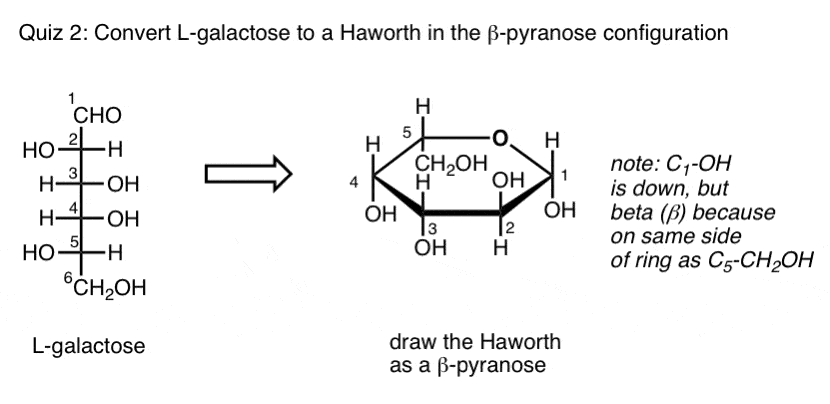
- Going to the Fischer from L-α-idopyranose

- Fructose drawn as a β-furanose:
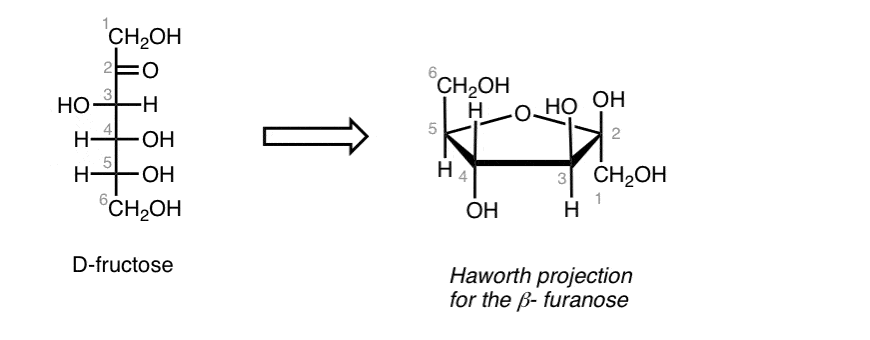
It's beta here because the OH on the anomeric carbon (C2 in this case) is on the same face as the group on the C5 carbon (CH2OH).
Note that whatever the sugar you are given, the mental exercise of rotating the Fischer 90 degrees clockwise is useful for determining which groups will be up and which will be down.
Note 1- it's very important that it's clockwise andnot counterclockwise, otherwise it won't be an accurate Haworth projection according to convention.
(Advanced) References and Further Reading
- The conversion of open chain structures of monosaccharides into the corresponding Haworth forms
Desmond M. S. Wheeler, Margaret M. Wheeler, and Thomas S. Wheeler
Journal of Chemical Education 1982, 59 (11), 969
DOI: 1021/ed059p969 - Simple rule for the conversion of Fischer monosaccharide projection formulas into Haworth representations
M. Argiles
Journal of Chemical Education 1986, 63 (11), 927
DOI: 10.1021/ed063p927 - A mnemonic scheme for interconverting Fischer projections of open-chain monosaccharides and Haworth projections of corresponding alpha- and beta-anomeric forms
Jonathan Mitschele
Journal of Chemical Education 1990, 67 (7), 553
DOI: 1021/ed067p553 - A New Method To Convert the Fischer Projection of a Monosaccharide to the Haworth Projection
Qing-zhi Zhang and Shen-song Zhang
Journal of Chemical Education 1999, 76 (6), 799
DOI: 1021/ed076p799 - A Simple Paper Model Illustrates How To Cyclize Monosaccharides from Fischer Projections to Haworth
Chi H. Mak
Journal of Chemical Education 2018, 95 (8), 1336-1339
DOI: 1021/acs.jchemed.7b00832Other useful references: - Rules for determining d,l configurations in Haworth structures
Jerry L. Wilson
Journal of Chemical Education 1988, 65 (9), 783
DOI: 1021/ed065p783 - Calculation and specification of the multiple chirality displayed by sugar pyranoid ring structures
Robert S. Shallenberger, Ronald E. Wrolstad, and Laurie E. Kerschner
Journal of Chemical Education 1981, 58 (8), 599
DOI: 1021/ed058p599
How To Draw Haworth Projections
Source: https://www.masterorganicchemistry.com/2018/01/25/converting-a-fischer-projection-to-a-haworth-and-vice-versa/
Posted by: tranwastookey.blogspot.com

0 Response to "How To Draw Haworth Projections"
Post a Comment